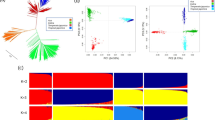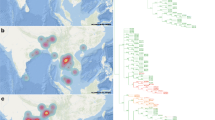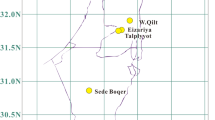Abstract
Flowering time is a major determinant for the local adaptation of crops. Hd1 is a key flowering-time gene in rice and is orthologous to the Arabidopsis CONSTANS gene. To elucidate the role of Hd1 in selection, we examined the Hd1 alleles of 60 landraces of Asian cultivated rice (Oryza sativa L.) originating from all regions of Asia, which comprised three cultivar groups, indica, japonica, and aus. The identified alleles were classified into four allele groups. The functional Hd1 alleles in allele groups I and II corresponded to indica and japonica, respectively. Non-functional alleles in these groups were not clearly associated with cultivar groups or locations. Allele groups III and IV corresponded to the aus cultivar group. The ancestry of each cultivar group was identified by the coalescent approach for Hd1 molecular evolution using the haplotype patterns of 14 regions over the 1.1 Mb chromosomal region surrounding Hd1 and the pSINE patterns of two loci, 1.4 and 4.4 Mb apart from Hd1. The haplotype patterns clearly revealed that Hd1 allele migration was caused by multiple and complex introgression events between cultivar groups. The Hd1 haplotypes among dozens of accessions of the wild species O. rufipogon were strongly divergent and only two of the haplotype clusters in O. rufipogon were closely related to those in cultivated rice. This strongly suggested that multiple introgression events have played an important role in the shaping and diversification of adaptation in addition to primary selection steps at the beginning of domestication.





Similar content being viewed by others
References
Bohlenius H, Huang T, Charbonnel-Campaa L, Brunner AM, Jansson S, Strauss SH, Nilsson O (2006) CO/FT regulatory module controls timing of flowering and seasonal growth cessation in trees. Science 312:1040–1043
Caicedo AL, Stinchcombe JR, Olsen KM, Schmitt J, Purugganan MD (2004) Epistatic interaction between Arabidopsis FRI and FLC flowering time genes generates a latitudinal cline in a life history trait. Proc Natl Acad Sci USA 101:15670–15675
Caicedo AL, Williamson SH, Hernandez RD, Boyko A, Fledel-Alon A, York TL, Polato NR, Olsen KM, Nielsen R, McCouch SR, Bustamante CD, Purugganan MD (2007) Genome-wide patterns of nucleotide polymorphism in domesticated rice. PLoS Genet 3:1745–1756
Cheng C, Motohashi R, Tsuchimoto S, Fukuta Y, Ohtsubo H, Ohtsubo E (2003) Polyphyletic origin of cultivated rice: based on the interspersion pattern of SINEs. Mol Biol Evol 20:67–75
Chiang GC, Barua D, Kramer EM, Amasino RM, Donohue K (2009) Major flowering time gene, flowering locus C, regulates seed germination in Arabidopsis thaliana. Proc Natl Acad Sci USA 106:11661–11666
Clement M, Posada D, Crandall KA (2000) TCS: a computer program to estimate gene genealogies. Mol Ecol 9:1657–1659
Corbesier L, Vincent C, Jang S, Fornara F, Fan Q, Searle I, Giakountis A, Farrona S, Gissot L, Turnbull C, Coupland G (2007) FT protein movement contributes to long-distance signaling in floral induction of Arabidopsis. Science 316:1030–1033
Fujino K, Sekiguchi H (2005a) Identification of QTLs conferring genetic variation for heading date among rice varieties at the northern-limit of rice cultivation. Breed Sci 55:141–146
Fujino K, Sekiguchi H (2005b) Mapping of QTLs conferring extremely early heading in rice (Oryza sativa L.). Theor Appl Genet 111:393–398
Fujino K, Sekiguchi H (2008) Mapping of quantitative trait loci controlling heading date among rice cultivars in the northernmost region of Japan. Breed Sci 58:367–373
Fujino K, Sekiguchi H, Sato T, Kiuchi H, Nonoue Y, Takeuchi Y, Ando T, Lin SY, Yano M (2004) Mapping of quantitative trait loci controlling low-temperature germinability in rice (Oryza sativa L.). Theor Appl Genet 108:794–799
Fujino K, Sekiguchi H, Kiguchi T (2005) Identification of an active transposon in intact rice plants. Mol Genet Genomics 273:150–157
Garris AJ, Tai TH, Coburn J, Kresovich S, McCouch S (2005) Genetic structure and diversity in Oryza sativa L. Genetics 169:1631–1638
Glaszmann JC (1987) Isozymes and classification of Asian rice varieties. Theor Appl Genet 74:21–30
Hayama R, Coupland G (2004) The molecular basis of diversity in the photoperiodic flowering responses of Arabidopsis and rice. Plant Physiol 135:677–684
Izawa T (2007a) Adaptation of flowering-time by natural and artificial selection in Arabidopsis and rice. J Exp Bot 58:3091–3097
Izawa T (2007b) Daylength measurements by rice plants in photoperiodic short-day flowering. Int Rev Cytol 256:191–222
Izawa T (2008) The process of rice domestication: a new model based on recent data. Rice 1:127–134
Izawa T, Takahashi Y, Yano M (2003) Comparative biology comes into bloom: genomic and genetic comparison of flowering pathways in rice and Arabidopsis. Curr Opin Plant Biol 6:113–120
Izawa T, Konishi S, Shomura A, Yano M (2009) DNA changes tell us about rice domestication. Curr Opin Plant Biol 12:185–192
Khush GS (1997) Origin, dispersal, cultivation and variation of rice. Plant Mol Biol 35:25–34
Kojima Y, Ebana K, Fukuoka S, Nagamine T, Kawase M (2005) Development of an RFLP-based rice diversity research set of germplasm. Breed Sci 55:431–440
Konishi S, Ebana K, Izawa T (2008) Inference of the japonica rice domestication process from the distribution of six functional nucleotide polymorphisms of domestication-related genes in various landraces and modern cultivars. Plant Cell Physiol 49:1283–1293
Lin HX, Yamamoto T, Sasaki T, Yano M (2000) Characterization and detection of epistatic interactions of 3 QTLs, Hd1, Hd2, and Hd3, controlling heading date in rice using nearly isogenic lines. Theor Appl Genet 101:1021–1028
Lin H, Ashikari M, Yamanouchi U, Sasaki T, Yano M (2002) Identification and characterization of a quantitative trait locus, Hd9, controlling heading date in rice. Breed Sci 52:35–41
Lin H, Liang Z-W, Sasaki T, Yano M (2003) Fine mapping and characterization of quantitative trait loci Hd4 and Hd5 controlling heading date in rice. Breed Sci 53:51–59
Lu JJ, Chang TT (1980) Rice in its temporal and spatial perspectives. In: Luh BS (ed) Rice: production and utilization. AVI Publishing Co Inc, Westport, pp 1–74
Mikami I, Uwatoko N, Ikeda Y, Yamaguchi J, Hirano HY, Suzuki Y, Sano Y (2008) Allelic diversification at the wx locus in landraces of Asian rice. Theor Appl Genet 116:979–989
Nonoue Y, Fujino K, Hirayama Y, Yamanouchi U, Lin S, Yano M (2008) Detection of quantitative trait loci controlling extremely early heading in rice. Theor Appl Genet 116:715–722
Osterberg MK, Shavorskaya O, Lascoux M, Lagercrantz U (2002) Naturally occurring indel variation in the Brassica nigra COL1 gene is associated with variation in flowering time. Genetics 161:299–306
Parsons B, Newbury H, Jackson M, Ford-Lloyd B (1999) The genetic structure and conservation of aus, aman and boro rices from Bangladesh. Genet Res Crop Evol 46:587–598
Putterill J, Robson F, Lee K, Simon R, Coupland G (1995) The CONSTANS gene of Arabidopsis promotes flowering and encodes a protein showing similarities to zinc finger transcription factors. Cell 80:847–857
Rozas J, Sanchez-DelBarrio JC, Messeguer X, Rozas R (2003) DnaSP, DNA polymorphism analyses by the coalescent and other methods. Bioinformatics 19:2496–2497
Second G (1982) Origin of the genetic diversity of cultivated rice (Oryza spp.): study of the polymorphism scored at 40 isozyme loci. Jpn J Breed 57:25–57
Shomura A, Izawa T, Ebana K, Ebitani T, Kanegae H, Konishi S, Yano M (2008) Deletion in a gene associated with grain size increased yields during rice domestication. Nat Genet 40:1023–1028
Sweeney MT, Thomson MJ, Cho YG, Park YJ, Williamson SH, Bustamante CD, McCouch SR (2007) Global dissemination of a single mutation conferring white pericarp in rice. PLoS Genet 3:e133
Tamaki S, Matsuo S, Wong H, Yokoi S, Shimamoto K (2007) Hd3a protein is a mobile flowering signal in rice. Science 316:1033–1036
Tsuji H, Tamaki S, Komiya R, Shimamoto K (2008) Florigen and the photoperiodic control of flowering in rice. Rice 1:25–35
Turner A, Beales J, Faure S, Dunford RP, Laurie DA (2005) The pseudo-response regulator Ppd-H1 provides adaptation to photoperiod in barley. Science 310:1031–1034
Uga Y, Nonoue Y, Liang ZW, Lin HX, Yamamoto S, Yamanouchi U, Yano M (2007) Accumulation of additive effects generates a strong photoperiod sensitivity in the extremely late-heading rice cultivar ‘Nona Bokra’. Theor Appl Genet 114:1457–1466
Vaughan DA, Kadowaki K-i, Kaga A, Tomooka N (2005) On the phylogeny and biogeography of the Genus Oryza. Breed Sci 55:113–122
Vaughan DA, Lu BR, Tomooka N (2008) The evolving story of rice evolution. Plant Sci 174:394–408
Yano M, Harushima Y, Nagamura Y, Kurata N, Minobe Y, Sasaki T (1997) Identification of quantitative trait loci controlling heading date in rice using a high-density linkage map. Theor Appl Genet 95:1025–1032
Yano M, Katayose Y, Ashikari M, Yamanouchi U, Monna L, Fuse T, Baba T, Yamamoto K, Umehara Y, Nagamura Y, Sasaki T (2000) Hd1, a major photoperiod sensitivity quantitative trait locus in rice, is closely related to the Arabidopsis flowering time gene CONSTANS. Plant Cell 12:2473–2484
Yano M, Kojima S, Takahashi Y, Lin H, Sasaki T (2001) Genetic control of flowering time in rice, a short-day plant. Plant Physiol 127:1425–1429
Yokoo M, Kikuchi F (1977) Multiple allelism of the locus controlling heading time of rice, detected using the close linkage with blast-resistance. Jpn J Breed 27:123–130
Acknowledgments
The seeds of the landraces and wild rice accessions used in this study were provided by the National Institute of Agrobiological Sciences and National Institute of Genetics, Japan, respectively. This research was supported partly by a grant from the Ministry of Agriculture, Forestry and Fisheries of Japan (Genomics for Agricultural Innovation, QTL5003).
Author information
Authors and Affiliations
Corresponding author
Additional information
Communicated by M. Yano.
K. Fujino and J. Wu contributed equally to this work.
Electronic supplementary material
Below is the link to the electronic supplementary material.
Rights and permissions
About this article
Cite this article
Fujino, K., Wu, J., Sekiguchi, H. et al. Multiple introgression events surrounding the Hd1 flowering-time gene in cultivated rice, Oryza sativa L.. Mol Genet Genomics 284, 137–146 (2010). https://doi.org/10.1007/s00438-010-0555-2
Received:
Accepted:
Published:
Issue Date:
DOI: https://doi.org/10.1007/s00438-010-0555-2




